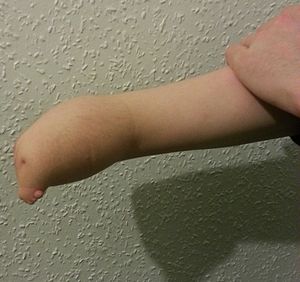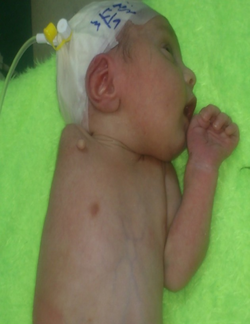Amelia (birth defect)
| Amelia | |
|---|---|
 | |
| Amelia affecting the right forearm | |
| Specialty | Medical genetics |
Amelia is the birth defect of lacking one or more limbs. It can also result in a shrunken or deformed limb. The term may be modified to indicate the number of legs or arms missing at birth, such as tetra-amelia for the absence of all four limbs. A related term is meromelia, which is the partial absence of a limb or limbs. The term is from Greek ἀ- "lack of" plus μέλος (plural: μέλεα or μέλη) "limb"
Signs and symptoms

Amelia may be present as an isolated defect, but it is often associated with major malformations in other organ systems. These frequently include cleft lip and/or palate, body wall defects, malformed head, and defects of the neural tube, kidneys, and diaphragm. Facial clefts may be accompanied by other facial anomalies such as abnormally small jaw, and missing ears or nose. The body wall defects allow internal organs to protrude through the abdomen. Head malformations may be minor to severe with a near absence of the brain. The diaphragm may be herniated or absent and one or both kidneys may be small or absent.
Causes
Between 24 and 36 days after fertilization, development of limb(s) may be impeded. This may eventually lead to complete or partial absence of one or more than one limbs.[1] Tetra-amelia syndrome appears to have an autosomal recessive pattern of inheritance - that is, the parents of an individual with tetra-amelia syndrome each carry one copy of the mutated gene, but do not show signs and symptoms of the condition.[2] In a few cases, amelia may be attributed to health complications during the early stages of pregnancy, including infection, failed abortion or complications associated with removal of an IUD after pregnancy, or use of teratogenic drugs, such as thalidomide.[3]
Diagnosis
The diagnosis of tetra-amelia syndrome is established clinically and can be made on routine prenatal ultrasonography. WNT3 is the only gene known to be associated with tetra-amelia syndrome. Molecular genetic testing on a clinical basis can be used to diagnose the incidence of the syndrome. The mutation detection frequency is unknown as only a limited number of families have been studied. Affected infants are often stillborn or die shortly after birth.[4]
Management
A prosthesis can be given to compensate for the missing limb(s).
See also
References
- ↑ "Amelia". Encyclopedia.com. 2021-03-04. Archived from the original on 2020-08-14. Retrieved 2021-03-09.
- ↑ "Tetra-amelia syndrome". Archived from the original on 2020-08-14. Retrieved 2022-07-16.
- ↑ KAN Y, SEKINE H (November 1963). "Case of Total amelia Thought to be due to Thalidomide". Nippon Sanka Fujinka Gakkai Zasshi. 15: 1267–1274.
- ↑ "Tetra-Amelia Syndrome". GeneReviews®. University of Washington, Seattle. 1993. Archived from the original on 2010-03-05. Retrieved 2022-07-16.
External links
| Classification |
|---|